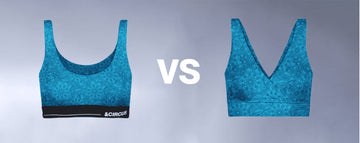In the vibrant textile bazaars of Tamil Nadu, where the rhythmic clatter of looms echoes through generations-old workshops, a subtle transformation is taking shape. Women in bustling Chennai streets pause to browse Pinterest on their phones, curating boards filled with visions of organic cotton undergarments and eco-friendly lingerie. This digital exploration mirrors a broader appetite for apparel that treads lightly on the planet. Spanning from Karnataka's innovative tech corridors to Delhi's dynamic urban pulse, data from Pinterest searches indicates a marked uptick in interest for sustainable fashion, especially in categories like lingerie and maternity wear. Far from a fleeting fad, this represents a profound evolution, anchored in India's rich weaving traditions and propelled by environmentally aware shoppers eager for change.
Uncomfortable underwear shouldn't steal your confidence. At Andcircus, we craft ultra-soft, sustainable Lenzing Modal Micro® innerwear for every body, XS to 5XL. From briefs to bras, our custom packs fit you perfectly. Shop risk-free with our 100% satisfaction guarantee and embrace comfort that includes everyone. #LoveEveryBody. Shop Now!
Pinterest Search Data Reveals Rising Demand for Sustainable Fashion in Key Indian States
Pinterest, the image-driven inspiration hub, offers a clear lens into India's shifting style preferences. Across regions including Maharashtra, Karnataka, Tamil Nadu, Delhi, Telangana, Uttar Pradesh, Gujarat, Haryana, Kerala, and West Bengal, queries for phrases such as organic cotton bras, eco-friendly maternity wear, and biodegradable underwear are on a consistent rise. A comprehensive sustainable fashion market report updated on September 11, 2025, underscores this momentum, projecting the global market to expand from US$ 10.09 billion in 2025 to US$ 24.99 billion by 2035, achieving a compound annual growth rate (CAGR) of 9.49% over that period. With a base year of 2024 and historical insights available, the 98-page analysis details market segmentation by type mass and premium and by application, encompassing shirts, yoga pants, leggings, shorts, and other items, many of which overlap with intimate apparel.
This growth narrative positions India's regional centers as crucial players, particularly in the Asia Pacific segment highlighted in the report. In Delhi and Maharashtra, users on Pinterest are increasingly exploring sustainable office ensembles incorporating intimate layers, such as airy organic cotton camisoles beneath professional suits. Tamil Nadu and Karnataka, meanwhile, witness heightened interest in lingerie crafted from organic cotton, prioritizing gentle, skin-compatible materials. In Kerala and West Bengal, deep-seated handloom practices fuel searches for sustainable garments that fuse artisanal heritage with contemporary green principles. These patterns not only reflect individual tastes but also dovetail with national efforts like the Make in India campaign, which bolsters eco-oriented textile advancements.
To understand this surge, consider the broader context. India's apparel sector, a cornerstone of its economy, is projected to grow substantially. For instance, the overall fashion market in India is expected to reach US$20.10 billion in 2025, with an annual growth rate of 15.19% through 2030. Within this, sustainable segments are gaining ground, driven by global pressures for reduced environmental impact. The fashion industry worldwide contributes significantly to carbon emissions around 10% globally and India alone is anticipated to generate 7.7 million tons of textile waste in 2025. Pinterest's role amplifies these concerns, as users curate ideas that blend aesthetics with ethics, influencing purchasing decisions in real time.
From Pins to Production: Real-World Impact
The momentum captured on Pinterest transcends virtual boards, directly influencing India's apparel manufacturing landscape. In Tamil Nadu's established textile clusters, local enterprises are integrating organic cotton from nearby cultivations into lingerie lines that emphasize comfort alongside environmental stewardship. Gujarat, renowned for its industrial textile prowess, is adapting facilities to produce biodegradable textiles, serving both local consumers and international buyers. Maharashtra's creative community harnesses Pinterest's visual platforms to promote understated sustainable undergarments, launching initiatives that connect with city dwellers in Mumbai and Pune.
Maternity apparel is experiencing a similar eco-transformation. Emerging companies in Telangana and Karnataka are introducing options free from harmful chemicals, designed for sensitive skin during pregnancy, and aligned with rising trends in mindful parenting. These firms utilize Pinterest to disseminate inspirational collages featuring muted, natural-hued nursing tops and supportive leggings, seamlessly merging fashion with green values. By analyzing platform data, businesses refine their offerings to better address regional needs, fostering a cycle where digital inspiration fuels tangible production shifts.
Expanding on this, consider how sustainable practices are embedding themselves in everyday fashion. Bamboo cotton, for example, is emerging as a favored fabric in 2025 trends, offering softness with minimal ecological footprint. In Indian contexts, this material adapts well to intimate wear, providing breathability in humid climates. Moreover, the push toward upcycling and recycled elements resonates on Pinterest, where boards dedicated to repurposed denim and eco-accessories are proliferating, encouraging a shift from fast fashion to enduring, responsible choices.
The Roadblocks to Going Green
Yet, transitioning to sustainable fashion presents formidable obstacles. In Gujarat and Tamil Nadu, despite solid infrastructural foundations, expanding production of green fabrics proves challenging. Organic cotton and decomposable materials demand advanced techniques that many smaller operations find cost-prohibitive. In Uttar Pradesh and West Bengal, constrained household budgets often make premium sustainable undergarments less accessible, perpetuating reliance on cheaper synthetics. Imagine a vendor in Kolkata's markets, amid piles of colorful artificial cloths, acknowledging that while online trends evolve, physical retail still favors economical, mass-made alternatives.
Supply chain issues compound these difficulties. Sourcing reliable sustainable inputs, such as organic fibers or bamboo derivatives, poses logistical hurdles in Maharashtra and Kerala. As Pinterest queries escalate, the backend infrastructure lags, compelling brands to navigate shortages and delays. This disparity reveals a fundamental mismatch: surging consumer curiosity outpaces the systemic readiness to deliver at volume. Additionally, awareness deficits persist; in rural or semi-urban areas of Haryana and Uttar Pradesh, knowledge of sustainable options remains limited, overshadowed by traditional buying habits.
Beyond logistics, regulatory and economic factors play roles. The Indian textile sector, while growing at rates like 3.35% annually from 2024 to 2029 for apparel, faces environmental scrutiny. Water-intensive dyeing processes and waste management issues demand innovation, yet adoption varies. Government reports highlight the need for integrated sustainability approaches, involving all stakeholders to mitigate these barriers.
Seizing the Green Opportunity
Amid these challenges, vast potential awaits. Online retailers in Delhi, Maharashtra, and Karnataka leverage Pinterest analytics to hone their eco-lines, precisely reaching environmentally minded customers. Gujarat and Tamil Nadu's manufacturing sites are positioning for exports, capitalizing on worldwide demand for green intimate apparel. Projections from various analyses suggest robust growth; for sustainable fashion globally, a CAGR of 10.3% is anticipated from 2025 to 2034. In India, similar trajectories are evident, with the apparel market eyeing US$109.45 billion in 2025 and 3.26% annual growth thereafter.
Kerala and Telangana are specializing in maternity segments, where green parenting drives preference for organic, toxin-free products. Stores in Bengaluru and Delhi are innovating with AI-enhanced Pinterest advertising, customizing pitches for those querying sustainable lingerie. Such advancements illustrate a synergy between digital tools and age-old craftsmanship, birthing a fashion framework that's planetary-friendly and culturally resonant. Initiatives like the Ministry of Textile's sustainability efforts and projects such as SusTex further bolster this, promoting eco-production and reducing industry footprints.
Looking ahead, collaborations between academia and industry, as seen in National Institute of Fashion Technology publications on sustainable education and practices, promise to cultivate skilled workforces. Economic incentives under Make in India encourage investments in green tech, potentially elevating India's global standing in ethical textiles. As e-commerce integrates these trends, opportunities for small artisans to reach wider audiences via platforms like Pinterest multiply, democratizing sustainable fashion.
A Greener Future for Indian Fashion
As twilight descends on Mumbai's horizon, a budding designer uploads a drawing of an organic cotton bralette to her Pinterest profile, envisioning lines that harmonize elegance and ecology. From Kerala's loom artisans to Bengaluru's digital entrepreneurs, the consensus is unmistakable: sustainable fashion has transcended specialty status. Pinterest's insights depict a nation primed for eco-intimate apparel adoption, spearheaded by Maharashtra, Karnataka, Tamil Nadu, and Delhi. With aligned efforts from brands, buyers, and authorities, India's textile realm is set to craft a more verdant tomorrow one inspiration, one weave, one mindful decision at a time.
Frequently Asked Questions
What does Pinterest data reveal about sustainable fashion trends in India?
Pinterest search data shows a significant increase in queries for sustainable fashion across major Indian states including Maharashtra, Karnataka, Tamil Nadu, and Delhi. Users are specifically searching for organic cotton bras, eco-friendly maternity wear, and biodegradable underwear, indicating a growing shift toward environmentally conscious fashion choices. This trend aligns with the global sustainable fashion market's projected growth from $10.09 billion in 2025 to $24.99 billion by 2035.
Which Indian states are leading the sustainable lingerie and intimate wear trend?
Delhi, Maharashtra, Tamil Nadu, and Karnataka are at the forefront of India's sustainable intimate wear movement. In Delhi and Maharashtra, users explore sustainable office ensembles with organic cotton camisoles, while Tamil Nadu and Karnataka show heightened interest in organic cotton lingerie. Kerala and West Bengal are also significant contributors, with their handloom heritage driving searches for sustainable garments that blend traditional craftsmanship with modern eco-friendly principles.
What challenges do Indian manufacturers face in producing sustainable fashion?
Indian sustainable fashion manufacturers encounter several key obstacles including high production costs for organic materials, supply chain difficulties in sourcing reliable sustainable inputs like bamboo derivatives, and infrastructure limitations in smaller operations. Additionally, constrained household budgets in states like Uttar Pradesh and West Bengal make premium sustainable undergarments less accessible, while awareness deficits in rural areas limit market adoption despite growing Pinterest interest in eco-friendly fashion.
Disclaimer: The above helpful resources content contains personal opinions and experiences. The information provided is for general knowledge and does not constitute professional advice.
You may also be interested in: How to Maintain Micromodal Underwear for Extended Use
Uncomfortable underwear shouldn't steal your confidence. At Andcircus, we craft ultra-soft, sustainable Lenzing Micro Modal innerwear for every body, XS to 5XL. From briefs to bras, our custom packs fit you perfectly. Shop risk-free with our 100% satisfaction guarantee and embrace comfort that includes everyone. #LoveEveryBody. Shop Now!







































